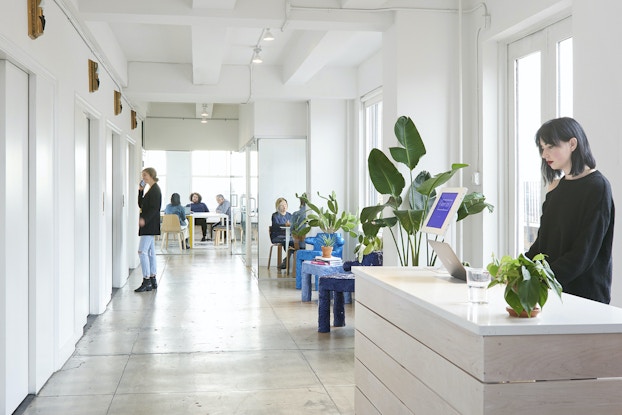
Mike Steib wants to make it easier to buy a $1 million Andy Warhol, or a $1,000 painting by a future Warhol, with just a few clicks on a mobile phone.
Steib became the CEO of the online art platform Artsy.net seven months ago. His job is to convert more of the millions currently viewing art on Artsy into buyers.
“There’s a lot of friction in the industry, and if we help to remove it, we can bring more people into the art world and bring more success to more artists and the galleries and auction houses that represent them,” Steib told CO—.
Artsy isn’t alone in the world of online art sales. There are numerous sites that either sell art directly, or connect buyers with galleries, and a growing number of galleries are launching their own online operations.
But Artsy is more aggressively reaching into the e-commerce toolbox and using some of same strategies as digitally native brands to make high-end art more shoppable. It is adding buy-now buttons and instant transaction options, and engaging customers with social media and mobile app alerts.

‘Democratizing collecting’
Artsy is “democratizing collecting … and shifting it away from the exclusivity of dealers,” Lisa Henry, an independent curator and educator based in the Los Angeles area, told CO—.
“It provides a non-intimidating way to see and study many periods of art before, or even instead of visiting a particular gallery,” Henry said.
The friction for consumers Steib sees in the industry include a lack of information about art and artists; a lack of price transparency, with prices not displayed on online art listings; and a lack of time to visit multiple galleries.
“The stereotype of an art collector as somebody who has money and time and spends days going to gallery after gallery is being replaced by a new batch of collectors who have money but no time,” he said.
Steib says he sees high net worth individuals buying art priced in the high six figures, or even over $1 million, online using the Artsy app.
“We can show people a million artworks in one place, and the fact that they’re eager to buy, and that we’re increasingly making that inventory not only shoppable, but quick to buy online, is really exciting,” Steib said.
“The company has an opportunity now to really start to scale.”
Online art sales reached $6 billion in 2018, up 11% over the previous year, and accounted for 9% of all sales, according to the 2019 Art Basel and UBS Global Art Market Report.
The stereotype of an art collector as somebody who has money and time and spends days going to gallery after gallery is being replaced by a new batch of collectors who have money but no time.
Mike Steib, CEO, Artsy
E-commerce ease
One of Artsy's top goals is to make art buying more achievable — with tactics like buy-now buttons and social media engagement techniques. Read on for more ways your e-commerce business can close sales quickly.
Artsy’s history
Artsy was born 10 years ago, the brainchild of a Princeton student, Carter Cleveland, who envisioned it as an online site where people could discover and collect art. Artsy offered galleries and dealers, many of which had been slow to enter the digital age, a way to display artwork online, and connect with potential buyers. It also provided editorial content about artists, art shows and auctions.
The website, which launched in 2012, did not sell art directly. Artsy made the online introductions, and it was up to the potential buyer to follow up by emailing or calling the gallery to ask about a piece of art.
Now Steib, who came to Artsy after five years as CEO of XO Group, the parent company of the wedding site, The Knot, wants to make it easier to go from meeting a piece of art online, to bringing it home.
The buy-now option, Steib said, eliminates the emails and phone calls between buyers and galleries that can postpone a purchase for days or weeks.
“No one’s buying art because they have to,” Steib said. “It’s a moment of passion. You fall in love with it. There’s a reason dating sites don’t tell you, ‘OK, now you have to send each other a bunch of emails and good luck meeting.’”
Artsy has close to 4,000 gallery, auction house and dealer partners that pay a monthly fee to post on the site. It has 1.7 million registered users and 2.3 million unique visitors each month. The Artsy app has been downloaded more than a million times.
Artsy has raised more than $100 million in investment funding, and attracted an impressive list of art, finance and tech experts to its board. Art patron Wendi Murdoch is a co-founder, investor and Artsy’s board director. Dasha Zhukova, the creator of the Garage Museum of Contemporary Art in Moscow, also is a co-founder and investor.

But is it profitable?
Artsy doesn’t reveal its finances, or whether it is profitable. Steib answers that question by saying, “We have really smart investors, a really good board of directors, and we have a sustainable business model. It’s not hard for you to imagine how people can build a really great business around making all the art in the world available online. And we are in the process of investing in that business and making it a success.”
Artsy also doesn’t disclose what galleries and other partners pay to list on the site, or reveal what its commission is on buy-now or consignment sales, saying the rates vary depending on the type of plan the gallery signs up for.
The buy-now option and a consignment feature Artsy is testing are expected to generate additional revenues for the company. Artsy earns commissions on buy-now sales and on consignment sales. In consignments, it matches sellers with galleries or dealers, who accept the consigned piece and offer it for sale.
What happens if, in a moment of passion, someone buys a pricey piece of art and has regrets the next day?
Disputes are handled by the gallery or dealer that sold the art, but Artsy has a collector relations team that helps resolve problems. The company also said it has systems in place to ensure that sellers meet high standards.
Steib sees more opportunities down the road to connect online shoppers with art, like via wish lists, or even wedding registries.
Connecting more people with art will not only be good for Artsy’s bottom line, but it will create more art lovers, and help more artists make a living through their art, he said.
“We have to grow demand for art,” Steib said. “If you think about it, 98% of millionaires do not collect art. That’s crazy. That people who will buy a $100,000 car or a $5,000 handbag are not connecting to the most beautiful works of art in the world is a missed opportunity. And as we take the friction out of the shopping — the discovery and buying process — we’re going to bring more and more of these people into the art world.”
CO— aims to bring you inspiration from leading respected experts. However, before making any business decision, you should consult a professional who can advise you based on your individual situation.
Want to read more? Be sure to follow us on LinkedIn!
CO—is committed to helping you start, run and grow your small business. Learn more about the benefits of small business membership in the U.S. Chamber of Commerce, here.






